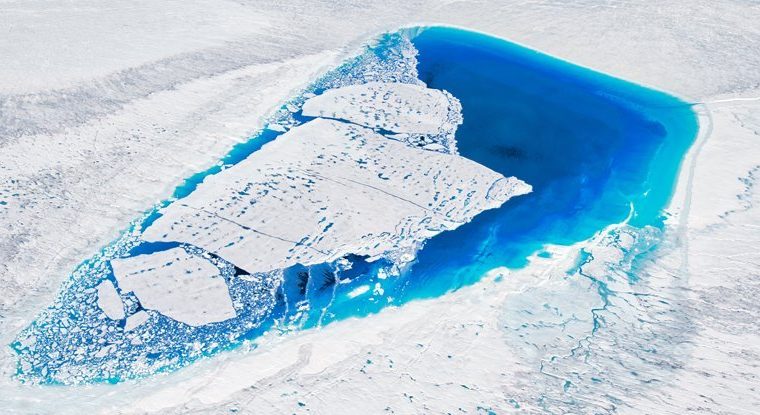
Greenland is the largest island in the world and has the largest ice mass in the northern golfers. If all that ice melted, the ocean would rise More than 7 meters.
But it’s not going to happen, is it? Well, not too soon, but realizing how much ice sheet could melt over the next century is a critical and important question that scientists are trying to deal with using micro numerical models of ice sheets. The rest interacts with the weather system.
The problem is that the models are not so good at reproducing recent observations and are limited by our poor knowledge of the sub-glass area and the elaborate topography of the Fjords, in which snow passes and falls.
One way around this problem is to see how the ice sheet reacted to changes in the weather in the past and compared the predictions of models for the future with changes in temperature. That’s what my colleagues and I just did in a new study published in a journal Nature communication.
We looked at three of Greenland’s largest glaciers, and scientists used historical aerial photographs with measurements taken directly over the years to reconstruct how the amount of these glaciers changed between 1880 and 2012. Was.
The approach is based on the idea that the past can help inform the future, not only in science, but in all aspects of life.
But unlike other “classes” in history, the future weather and earth system will not be a carbon copy of the past. Nevertheless, if we understand how sensitive the ice sheet has been to temperature changes in the last century, it can provide a useful guide to how it will react in the next century.
We found that the three largest glaciers were responsible for an 8.1 mm rise in sea level, about 15 percent of the total ice sheet contribution.
During the period of our study, the sea level has risen by about 20 centimeters globally, about the height of an A5 booklet, and about that, the width of a finger is entirely due to the melting of the ice from those three Greenland glaciers.
Usually melting
So what does this tell us about the future behavior of the ice sheet? In 2013, a Modeling studies Fez Nick and colleagues looked at the same “big three” glaciers (Jacobshavan Isbrai in the west of the island and Helhem and Kangerlusuak in the east) and predicted how they would respond in different future seasons.
These scenes are called the most RCP 8.5 And it believes that economic growth will continue throughout the 21st century, resulting in a global mean temperature of about 3.7 ˚ C (4.8 ˚ C above pre-industrial levels or after 1850).
This scenario is sometimes referred to as Business General (BAU), and is one Active debate About how difficult RCP 8.5 is among weather researchers. It is interesting to note, however, that according to a recent study by a group of US scientists, this may be the most appropriate scenario. At least until 2050.
Because of something Polar applicationThe Arctic is likely to accelerate more than twice the global average, with climate models indicating a very moderate 8.3 degrees Celsius on Greenland, RCP 8.5.
Despite this dramatic and dramatic rise in temperature, Fez’s modeling study predicts that the “big three” will contribute to raising the sea level by 2100, which is exactly what we will achieve in the 20th century, just over 1.5 degrees Celsius. . .
How can this be?
Our conclusion is that there is a dearth of models, even Available with the latest and best available modes Which is being used to assess how the whole ice sheet will respond to the next century Climate change.
These models show a relatively weak link between climate change and ice melting, when Our results Suggest that it is too strong.
Estimates based on these models are therefore less likely to be underestimated by the impact on the ice sheet. Other lines of evidence Support This Conclusion.
What does all this mean? If we continue with the increasingly frightening RCP 8.5 greenhouse gas emissions, Greenland’s ice sheets will begin to melt at very low rates we haven’t seen for at least 130,000 years, the sea floor and its dire consequences. With being. Many millions of people Who live in low-lying coastal areas.
Jonathan Bomber, Professor of Physical Geography, University of Bristol.
Our conclusion is that there is a dearth of models, even Available with the latest and best available modes Which is being used to assess how the whole ice sheet will respond to the next century Climate change.
These models show a relatively weak link between climate change and ice melting, when Our results Suggest that it is too strong.
Estimates based on these models are therefore less likely to be underestimated by the impact on the ice sheet. Other lines of evidence Support This Conclusion.
What does all this mean? If we continue with the increasingly frightening RCP 8.5 greenhouse gas emissions, Greenland’s ice sheets will begin to melt at very low rates we haven’t seen for at least 130,000 years, the sea floor and its dire consequences. With being. Many millions of people Who live in low-lying coastal areas.
Jonathan Bomber, Professor of Physical Geography, University of Bristol.
No comments:
Post a Comment